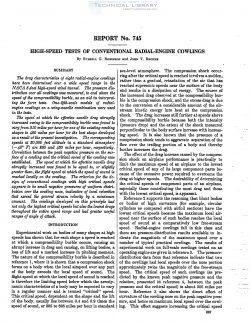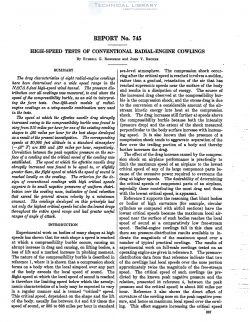naca-report-745

- Version
- 129 Downloads
- 1.16 MB File Size
- 1 File Count
- August 30, 2016 Create Date
- August 30, 2016 Last Updated
National Advisory Committee for Aeronautics, Report - High Speed Tests of Conventional Radial Engine Cowlings

The drag characteristics of eight radial-engine cowlings
hare bee-n determined orer a wide speed range in the
NAOA 81foothigh-speed wind tunnel. The pressure dis-
tribution orer all cowli—ngs was measured, to and above the
speed of the compressibility burble, as an. aid in interpret—
ing the force tests. One-fifih—scale models of radial-
engine cowlings on a uringmacdle combination were used
in the tests.
The speed at which the efectice nacelle drag abruptly
increased owing to the compressibility burble was found to
vary from 310 miles per hour for one of the eristing cowli-ng
shapes to 480 miles per hour for the best shape deceloped
as a result of the present incestigation. The corresponding
speeds at 80,000 feet altitude in a standard atmosphere
(—48" F) are 280 and 430 miles per hour, respectively.
Correlation bet-ween. the peak negatice pressure on the sur-
face oj a cowling and the critical speed of the cowling was
established. The speed at which the efectire nacelle drag
abruptly increased was found to be equal .to, or slightly
greater than, the flight speed at which the speed of sound is
reached locally on the cowling. The criten'an for the de-
sign of concentional cowli-ngs un'th high critical speeds
appears to be small negative pressures of unifonn distri»
bution over the cowling nose, indicative of local velocities
that exceed the general stream relocity by a minimum
amount. The cowlings developed on this principle had
not only the highest critical speeds but also the lowest drags
throughout the entire speed range and had greater useful
ranges of angle of attack.
Experimental work on bodies of many shapes at high
speeds has shown that for each shape a speed is reached
at which a compressibility burblc occurs, causing an
abrupt increase in drag and causing, on lifting bodies, a
loss of lift and a marked increase in pitching moment.
The nature of the compressibility burble is described in
reference 1, where it is shown that a compression shock
forms on a body when the local airspeed over any part-
of the body exceeds the local speed of sound. The
flight speed at which the local speed Of sound is reached
is therefore the limiting speed below which the aerody-
namic characteristics of a body may be expected to vary
in a regular manner and is termed “critical” speed.
| File | Action |
|---|---|
| naca-report-745 High Speed Tests of Conventional Radial Engine Cowlings.pdf | Download |
Comment On This Post